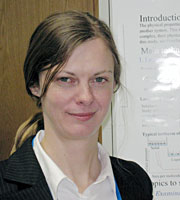Thin films whose physico-chemical properties can be readily controlled and changed as desired at the needed time are required for biological and technical applications. Examples of thin films commonly used that may face changes in their properties due to wearing and contact with the surrounding environment are lubricating surfaces of MEMs, biofilms that are used to prevent abrasion between two joints in the body, e.g., the knee, and the scaffolding used to regenerate cells in the body. Control of the physico-chemical properties of thin films, e.g., visco-elasticity, surface charge, and morphology, may lead to an increased retention time and efficiency of the thin film, even if the surface is subjected to much abrasion and mechanical contact. The charge of a surface affects the adhesion ability of a material to that surface, and also the morphology and chemical properties of the surface. The morphology of the surface may change the frictional properties of the thin film, affecting the lubrication ability of the thin film and the surface roughness. A thin film with properties matching a single system can now be reasonably well made. However, the properties of biological and mechanical systems constantly change with time and the environment. As a result, the required parameters of the thin film change as the surroundings evolve with time.
Profile

McNAMEE, Cathy Elizabeth
- Research Area:
- Physico-chemical characterization of interfaces and surfaces
- keywords:
- Colloid chemistry; Surface chemistry; Atomic Force Microscope; Langmuir trough; Fluorescence Microscope.
- Contact:
- 3-15-1 Tokida, Ueda-shi, Nagano-ken
Japan 386-8567
Tel: +81-268-21-5585
E-mail: mcnamee[at-mark]shinshu-u.ac.jp
- McNamee, C.E.*, Yamamoto, S., Butt, H.-J., Higashitani, K. “A straightforward way to form close-packed TiO2-particle monolayers at an air/water interface.” Langmuir, 2011, 27, 887-894.
- McNamee, C.E.*, Graf, K., Butt, H.-J., Higashitani, K., Kappl, M. “Interaction between a silica particle and the underside of a polymer monolayer at the air/water interface in the presence of an anionic surfactant.”, Colloid Surf. A-Physicochem. Eng. Asp., 2011, 383, 32-40.
- McNamee, C.E.*, Nakayama, M., and Higashitani, K.* “Molecular-Scale Change in the Surface Properties of Silica and Copper in Pure Water with Time.” Langmuir, 2010, 26, 15310-15315.
- McNamee, C.E.*, Kappl, M., Butt, H.-J., Higashitani, K., Graf, K.* “Interfacial Forces between a Silica Particle and Phosphatidylcholine Monolayers at the Air-Water Interface.”, Langmuir, 2010, 26, 14574-14581.
- McNamee, C.E.*, Butt, H.-J., Higashitani, K., Vakarelski, I.U., and Kappl, M. “Interaction of cationic hydrophobic surfactants at negatively charged surfaces investigated by Atomic Force Microscopy.” Langmuir, 2009, 25, 11509-11515.
Research Statement
My goal:
Our aim is to make thin films whose surface properties adjust as needed when the properties of the surroundings change. We therefore need to first understand how the physico-chemical and mechanical properties of a surface change with time and the environment. Here, we aim to understand the surface properties of biological and nano-technological devices and the effect of the environment on their physical properties.
The Langmuir trough is being used to create monolayers that model biological membranes, monolayers that are used to create nano-technological materials, etc. Chemically modified silica surfaces for use as biofilms are being prepared using silane coupling agents and additional surface chemical reactions. Fluorescence microscopy is used to determine the packing and structure of the molecules in the monolayer at the air/liquid interface in-situ. The Atomic Force Microscope is used to investigate the surface properties of a film transferred to a solid surface.